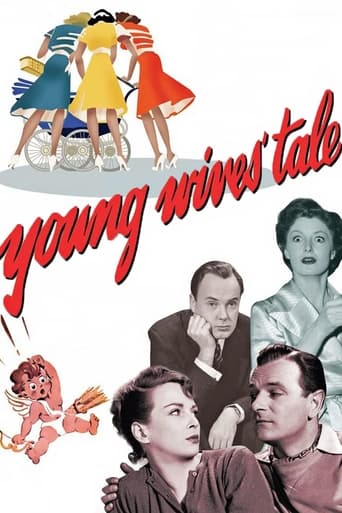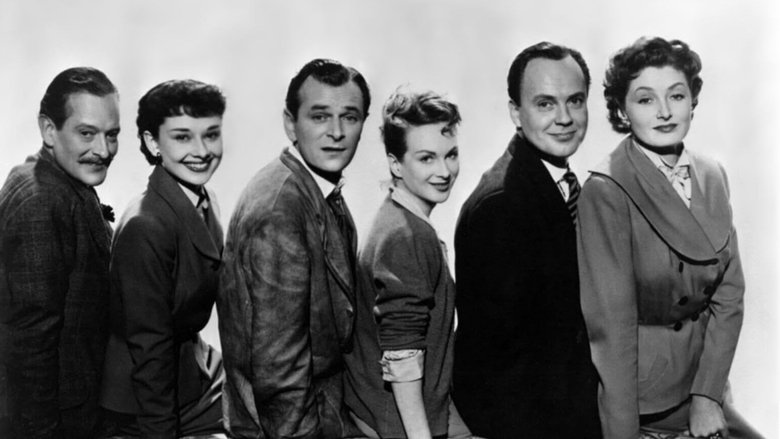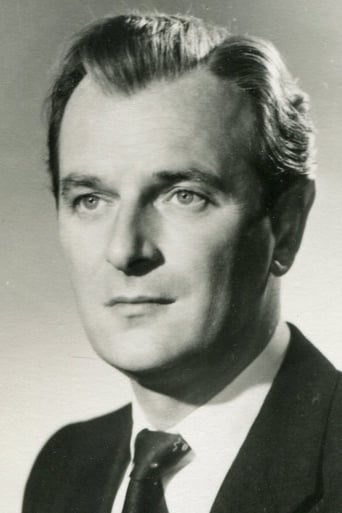

Young Wives' Tale (1951)
A post-war housing crisis leaves a shy woman to share a house with two couples. Comic situations arise as the new roomer becomes infatuated with one of the husbands.
Watch Trailer
Cast
Reviews
Just perfect...
This movie was so-so. It had it's moments, but wasn't the greatest.
After playing with our expectations, this turns out to be a very different sort of film.
A terrific literary drama and character piece that shows how the process of creating art can be seen differently by those doing it and those looking at it from the outside.
This is a movie version of one of those brittle post-war stage farces, originally written by Ronald Jeans. Given then-current housing shortages, two couples -- Joan Greenwood & Nigel Patrick; Derek Farr & Helen Cherry -- are sharing a house. Each has one toddler, and only Miss Greenwood to work act dogsbody for the menage. Given her super-posh accent, she is an absolute flub at it, but she does get to show some athleticism as she leaps from one disaster to the next. When Miss Cherry locates a decent nanny for the children in the person of Athene Seyler, everyone thinks for a moment that the situation is saved, but for the purposes of the plot, they tell her the children are siblings, and she believes Miss Greenwood is married to Mr. Farr. The usual comedy of misconstruction ensues, carried on by speed by and the abilities of the cast. Alas, the effort never quite opens up beyond its stage origins.Movie fans will want to see this for a sizable supporting role by Audrey Hepburn. She plays a young woman who has a room in the house and whose salient quality is she is terrified of men. Although her character connects loosely with the plot at several points, I had the distinct impression that at some stage of the movie's origins -- perhaps before the play actually opened -- the role was actually much larger. Now it is largely vestigial, even if it is the main reason the movie is remembered.
Joan Greenwood (Sabina Pennant), Nigel Patrick (Rodney Pennant), Derek Farr (Bruce Banning), Guy Middleton (Victor Manifold), Athene Seyler (Nanny Gallop), Helen Cherry (Mary Banning), Audrey Hepburn (Eve Lester), Fabia Drake (Nurse Blott), Irene Handl, Joan Sanderson (nurses — Regents Park), Selma Vaz Dias (Ayah), Jack McNaughton (taxi driver), Brian Oulton (man in pub), Carol James (Elizabeth).Director: HENRY CASS. Screenplay: Anne Burnaby. Based on the 1949 stage play by Ronald Jeans. Photography: Erwin Hillier. Film editor: E. Jarvis. Music composed by Philip Green, played by the Associated British Studio Orchestra, conducted by Louis Levy. Art director: Terence Verity. Make-up: Bob Clark. Hair styles: A. G. Scott. Set continuity: Thelma Orr. Camera operator: Norman Warwick. Scenario editor: Frederic Gottfurt. Production manager: William A. Whittaker. Sound recording director: Harold V. King. RCA Sound System. Producer: Victor Skutezky.Copyright 15 August 1952 by Stratford Pictures Corp. New York opening at the Paris: 3 November 1952. U.S. release through Stratford: 9 June 1952. Made by Associated British Picture Corp., London. Released in the U.K. through Associated British-Pathe: 12 November 1951. Australian release through 20th Century-Fox: 23 April 1953 (sic). 7,108 feet. 79 minutes.SYNOPSIS: The housing shortage causes two families to share the one house.COMMENT: Little more than a photographed stage play. Only the slightest bit of opening-out is attempted. The core of the script is indifferent, with humor of the most basic and elementary slapstick and the usual stage caricatures. Nigel Patrick plays the bumbling, fall-over-anything-and-everything dad; Joan Greenwood the put-upon housewife who yearns to be glamorous; Guy Middleton once again cast as a ridiculously obvious would-be seducer; Helen Cherry is the toughie with a job; while Derek Farr essays the mild-mannered spouse; Athene Seyler does her bit as a doting nanny; while last but certainly not least in this second-rate company, Audrey Hepburn appears as a man-shy butterfly.Yes, I realize Audrey's presence is the main reason anyone would want to see this film, but be warned her role is small, though it does run through the whole play. In fact she has a couple of scenes and even a few close-ups. Although she acts in her usual prissy style (more so, if anything), she is neither flatteringly photographed nor costumed. Still fans will not have any trouble recognizing her. You can close your eyes even. That too-too upper- echelon voice and that arch dialogue delivery is an absolute trademark.Three or four very mild jokes enliven the single plot twist (the boofhead nanny gets the two couples confused) before an ineptly staged slapstick finale finally puts both audience and cast out of their misery.Cass's direction is surprisingly pedestrian. He's supposed to be a first-class and totally experienced Joe, but I wouldn't even engage him to direct traffic in a one-way street. Photography and other credits are also distinctly second class; and production values rate definitely way below economy class.
This is one of those mediocre British farces from the early 1950s were every one rushes around talking as loudly as they can in the hope that the volume of their speech will make up for the paucity of wit contained in the script.The leading pair are Nigel Patrick in an unusual domestic role,for him anyway,and the delectable Joan Greenwood,who had recently starred magnificently in Kind Hearts and Coronets.Supporting them adequately are Helen Cherry,Guy Middleton and Athene Seyler.However the main matter of note is the featuring of Audrey Hepburn who would not long be constrained by her contract with Associated British picture Corporation.I doubt that she remembered this film with any fondness.
I bumped up the user rating on this film to 8/10 as I was disappointed to see it rated so low at 5.2/10.This 1951 film is mainly acted out on one set - a suburban house - so I suspect it was again another filmed stage play.The plot concerns the marriage teething problems of two couples who share the same house, Joan Greenwood (Sabina Pennant), Nigel Patrick (Rodney Pennant) and Helen Cherry ((Mary Banning - Sabina's elder career minded sister), Derek Farr (Bruce Banning).After WWII in Britain many married couples had to live with their parents (or in-laws) as mortgages for owner occupied properties were very difficult to obtain then.Many houses had been blitzed and the Government started a "prefab" scheme to rehouse poorer occupants.I was born in 1946 and was therefore 5 years old when this was filmed but I can empathise with the post war economic problems having lived then as a child.The main problem for ex-actress Joan Greenwood (mother to a 2 1/2 year old son) is to find a reliable nanny after the first one (Fabia Drake) leaves "in a huff".Likewise career mother, Helen Cherry, is mother to a young 2 year old daughter.As Sabina is getting stressed out coping with all the housework (laundry/food preparation/child care etc.), her sister finds a veritable treasure replacement nanny (Athene Seyler) whom she finds in the park.Due to a silly misunderstanding concerning morality with the nanny, the couples have to pretend to be married to each other.The farce is further complicated by the addition of two friends who regularly pop into the house, Guy Middleton, (Victor Manifold), who is close to Sabina and a 22 year old Audrey Hepburn (Eve Lester), who is close to Rodney.Of course there are pretend affairs, rows, reconciliations in true farce style.The acting is professional rep. standard.This was the first time I had seen this film and I enjoyed it immensely.


